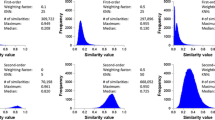Abstract
Recent studies on first- and second-order similarities have shown that the latter one outperforms the first one as input for document clustering or partitioning applications. First-order similarities based on bibliographic coupling or on lexical approaches come with specific methodological issues like sparse matrices, sensitive to spelling variances or context differences. Second-order similarities were proposed to tackle these problems and take the lexical context into account. But also a hybrid combination of both types of similarities proved an important improvement which integrates the strengths of the two approaches and diminishes their weaknesses. In this paper we extend the notion of second-order similarity by applying it in the context of the hybrid approach. We conclude that there is no added value for the clearly defined clusters but that the second-order similarity can provide an additional viewpoint for the more general clusters.




Similar content being viewed by others
References
Ahlgren, P., & Colliander, C. (2009). Document–document similarity approaches and science mapping: experimental comparison of five approaches. Journal of Informetrics, 3(1), 49–63. doi:10.1016/j.joi.2008.11.003
Bichteler, J., & Eaton, E. A. (1980). The combined use of bibliographic coupling and co-citation for document retrieval. JASIS, 31(4), 278–282. doi:10.1002/asi.4630310408
Boyack, K. W., & Klavans, R. (2010). Co-citation analysis, bibliographic coupling, and direct citation: which citation approach represents the research front most accurately? JASIST, 61(12), 2389–2404. doi:10.1002/asi.21419
Braam, R. R., Moed, H. F., & van Raan, A. F. J. (1991a). Mapping of science by combined co-citation and word analysis, part 1: structural aspects. JASIS, 42(4), 233–251. doi:10.1002/(SICI)1097-4571(199105)42:4<233::AID-ASI1>3.0.CO;2-I
Braam, R. R., Moed, H. F., & van Raan, A. F. J. (1991b). Mapping of science by combined co-citation and word analysis part II: dynamical aspects. JASIS, 42(4), 252–266. doi:10.1002/(SICI)1097-4571(199105)42:4<252::AID-ASI2>3.0.CO;2-G
Colliander, C., & Ahlgren, P. (2011). Experimental comparison of first and second-order similarities in a scientometric context. Scientometrics, 90(2), 675–685. doi:10.1007/s11192-011-0491-x
Glänzel, W. (2012). The role of core documents in bibliometric network analysis and their relation with h-type indices. Scientometrics, 93(1), 113–123. doi:10.1007/s11192-012-0639-3.
Glänzel, W., Janssens, F., & Thijs, B. (2009). A comparative analysis of publication activity and citation impact based on the core literature in bioinformatics. Scientometrics, 79(1), 109–129. doi:10.1007/s11192-009-0407-1
Glänzel, W., & Thijs, B. (2011). Using `core documents’ for the representation of clusters and topics. Scientometrics, 88(1), 297–309. doi:10.1007/s11192-011-0347-4
Glänzel, W., & Thijs, B. (2012). Using ‘core documents’ for detecting and labelling new emerging topics. Scientometrics, 91(2), 399–416. doi:10.1007/s11192-011-0591-7.
Janssens, F. (2007). Clustering of scientific fields by integrating text mining and bibliometrics. Ph.D. Thesis, Faculty of Engineering, Katholieke Universiteit Leuven, Belgium. http://www.hdl.handle.net/1979/847.
Kopcsa, A., & Schiebel, E. (1998). Science and technology mapping: a new iteration model for representing multidimensional relationships. JASIS, 49(1), 7–17. doi:10.1002/(SICI)1097-4571(1998)49:1<7::AID-ASI3>3.0.CO;2-W
Picard, J. (1999), Finding content-bearing terms using term similarities. In Proceedings of EACL’99, 241–244.
Rousseeuw, P. (1987). Silhouettes: a graphical aid to the interpretation and validation of cluster analysis. Journal of Computational and Applied Mathematics, 20(1), 53–65. doi:10.1016/0377-0427(87)90125-7
Schiebel, E. (2012). Visualization of research fronts and knowledge bases by three-dimensional areal densities of bibliographically coupled publications and co-citations. Scientometrics, 91(2), 557–566. doi:10.1007/s11192-012-0626-8.
Zitt, M., & Bassecoulard, E. (1994). Development of a method for detection and trend analysis of research fronts built by lexical or co-citation analysis. Scientometrics, 30(1), 333–351. doi:10.1007/BF02017232
Acknowledgments
This is a version of a paper presented by the first author at the 17th International Conference on Science and Technology Indicators (Montreal, 5–8 September 2012). The full proceedings are published as: E. Archambault, Y. Gingras, V. Lariviere (Eds.), Proceedings of STI 2012 Montreal, Science-Metrix and OST, Montréal, Quebec, Canada.
The methodology has partially been developed in the context of the ERACEP project within the Coordination and Support Actions (CSAs) of the ERC work programme. The authors wish to acknowledge this support.
Author information
Authors and Affiliations
Corresponding author
Rights and permissions
About this article
Cite this article
Thijs, B., Schiebel, E. & Glänzel, W. Do second-order similarities provide added-value in a hybrid approach?. Scientometrics 96, 667–677 (2013). https://doi.org/10.1007/s11192-012-0896-1
Received:
Published:
Issue Date:
DOI: https://doi.org/10.1007/s11192-012-0896-1




